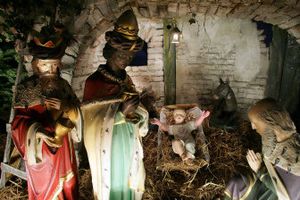The Nativity Scene
The nativity scene offers us comfort at this time of year and a visual reminder of the Advent and Christmas seasons.
While the nativity scene is a tradition, where did the tradition come from and what do the symbols mean? What is history and what is “art”? Some answers are found in the Bible and some of our symbols came to us over time.
The first nativity scene – a living scene - was created by St. Francis of Assisi in 1223. He wanted to cultivate the worship of Christ at a time when there were few books and few skilled readers. St. Francis was a lover of animals; he is often depicted with animals and described as able to communicate with them. So it is no surprise that our nativity scenes are filled with animals – particularly an ox and an ass.
We really do not know what – if any – animals were present at Jesus’ birth, but the symbolism of the creatures we set in our stables, do offer rich meaning. Perhaps Francis read from an 8th century text not included in the Bible: “And on the third day after the birth of our Lord Jesus Christ, Mary went out of the cave, and, entering a stable, placed the child in a manger, and an ox and an ass adored him. Then was fulfilled that which was said by the prophet Isaiah, ‘The ox knows his owner, and the ass his master’s crib.’ ”
And so the ox and ass are now part of our tradition. The ox symbolizes patience, Israel and the Old Testament, while the ass symbolizes humility, service and The Gentiles.
The sheep and shepherds were typical of the time of Jesus’ birth and referenced in Luke’s Gospel: “There were country shepherds living out in the fields, keeping watch over their flock by night. And an angel of the Lord stood before them and the glory of the Lord shone around them.”
The light in the manger represents the star from Matthew’s Gospel that illuminated the sky and the light of Christ that continues to illuminate our lives. The “wise men” from Matthew’s Gospel were dispatched by King Herod to find the child and return with word about Jesus’ location. We do not know if there were actually three wise men, only three gifts of gold, frankincense and myrrh. The wise men – called Magi - were likely astrologers, familiar with the night sky. The Magi did not follow orders to return and inform King Herod.
Jesus rests in the manger as the center of our story: a story of hope, healing, brought to us in the simplicity of a child.
As Christmas unfolds in our lives, may the nativity scene offer you a message of light, of hope, of joy.
(S-R photo archives: Wise men bring gold and frankincense at a Nativity scene in Amsterdam, Netherlands, December 2006)
